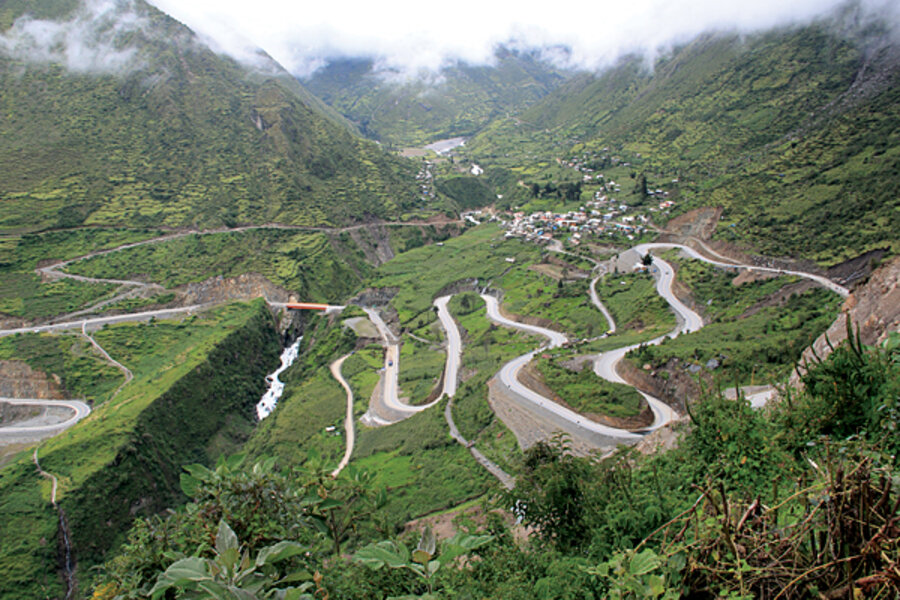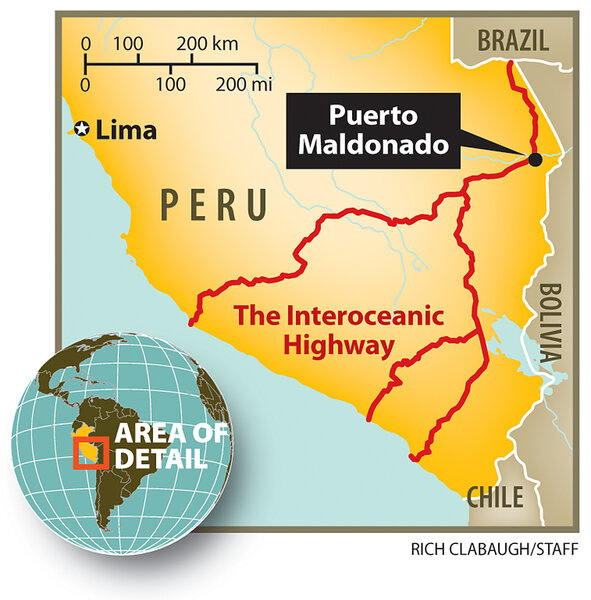Peru's new highway to the future
Loading...
| Puerto Maldonado, Peru
Traveling from Brazil’s Atlantic coast to Assis, on the border with Peru deep in the Amazon, took Raul Pereira weeks over a precarious dirt road in 1974. The trip required machetes.
Today, his house and workshop are on a paved road. “This was an animal trail in those days," he says.
For years, Assis was the end of the road. Traveling on through the Peruvian Amazon and over the Andes was an adventure on mud tracks. Asked how business is at his roadside mechanic's workshop, the Brazilian gives a thumbs-down. And the lack of a road didn't just hurt his business, but also cut billions of dollars in potential trade between Brazil and Peru.
That’s about to change. After decades of delay, Peru is on the verge of completing the $2.75 billion Interoceanic Highway connecting Mr. Pereira's house – and the rest of Brazil – to the west coast. Pereira, and millions more Brazilians and Peruvians, will see their lives change radically once they live along the continent’s first true transcontinental highway.
Traffic is already growing. Cesar Bonamigo, a diplomat at the Brazilian embassy in Lima, says 3,500 people crossed the border in 2006. As crews laid asphalt in 2009, he says, that rose 10-fold to 35,000.
The last major link in the Interoceanic Highway, a bridge over the Madre de Dios river 143 miles away, is set to open this month. The last rivet in the bridge will be like the golden spike which, in 1869, completed North America’s first transcontinental railroad. There is a road connecting Argentina to Chile, and a roundabout route through Bolivia. But this is the first two-lane, year-round highway across the continent's waist, from the Amazon directly to the Pacific.
From Sao Paulo, near the Atlantic, the highway traverses 2,439 miles of Brazil, crossing coastal hills, soy-farming plains, and the cattle pastures where Amazon rain forest once stood. At last, just beyond Pereira's home, it crosses the Acre River into Peru. The Christian Science Monitor traversed Peru's new road to glimpse its villages and landscapes before they change beyond recognition.
The bridge
From the border, it's a two-hour drive south across rolling farmland to the tiny village of Triunfo. Scattered spindly trees by the highway are reminders of the rainforest, long since logged over. Miles to the right, where the forests remain more intact, indigenous groups live in voluntary isolation, avoiding industrial society.
The road halts at the Madre de Dios River, a Mississippi-sized stream that flows south into Bolivia and Brazil before eventually joining the Amazon River. Across the river is the regional capital, Puerto Maldonado, with its cyber cafes, Chinese import shops, and air-conditioned hotels. But tiny Triunfo had never even been touched by asphalt until the highway was paved two years ago. Naked children still play on the dirt streets of the town. Buses and trucks cross the river on wooden ferryboats just big enough for a vehicle.
Rafael Gahona and Graciela Lopez live 200 yards upriver on a 35-hectare tract where mysterious flute-like sounds emanate from mahogany trees. Their house is built of lumber hewn from river driftwood and is flanked by mango, orange, banana, and cocoa trees. When they want to cross over to Puerto Maldonado, they go by motorized canoe. Like the natives upriver, they too live in a form of voluntary isolation, preferring the noises of monkeys and parrots rather than moto-taxis and dance clubs.
But this quiet life is about to end. The view from the riverbank is dominated by a towering, nearly complete suspension bridge. Every day, workers weld in more orange trusses, racing to complete the half-mile-long span before Alan Garcia's presidential term ends in July. The outgoing president sees the highway as a crowning achievement of his tenure.
Peru’s government first bought the bridge steel in 1980, but financial problems delayed construction for decades, says Biaggio Carollo, an engineer from Brazilian company Odebrecht who is in charge of building the bridge and hundreds of miles of nearby highway.
When the bridge opens, Mr. Gahona's property will suddenly be a 15-minute walk from the center of Puerto Maldonado. It would make the perfect spot for a luxury hotel – and Gahona has already fielded offers for the land.
If they sell, the Gahonas will have cash to pursue other dreams. But their fruit trees are likely to be cut, and the birds and monkeys will be pushed back into the woods.
Gold rush
West of Puerto Maldonado, the Interoceanica Highway splits. One branch goes to Cuzco, where tourists leave for Machu Picchu. The other branch goes to the trading post of Juliaca in the high desert near Lake Titicaca. Either route requires ascending well over 15,000 feet before dropping toward the sea.
In the Amazon near Puerto Maldonado, ramshackle mining camps have popped up, thanks to the rising price of gold and the easier access afforded by the new highway. At the village of Limonchayoc, a two-story-high yellow excavator is converting a deep green meadow into a wasteland of red upturned soil as a team seeks to extract gold dust from ancient river deposits.
The road's builders, including Mr. Carollo, say the illegal mining predates the road, and that the gold price is the main catalyst for the current boom. But old-time miners say the road has brought an influx of heavy equipment, making life harder for local prospectors.
"They never could have brought the heavy machinery in without this new highway," says Juan Mamani. "How could they have crossed that?"
Mr. Mamani gestures at a bridge of decayed concrete, set to collapse into a creek. Then the minibus we're in zips across its replacement – one of 141 new bridges for the Interoceanic Highway.
Mamani is a miner himself. His family couldn't afford to keep him in school, so he spent all his time in his father's gold camp from age six. He still has pumps and sluices, and plans to use their earnings to pay for his son's education. He says the easier access from the new road has made it possible for gangs to industrialize the area's unpermitted mines, closing off a chance for poorer Peruvians to seek a better life.
But like many of the highway's critics, Mamani acknowledges its benefits. He is rushing to Cuzco, where his wife is in the hospital and at risk of dying. Before 2006, he says, the trip could have taken 15 days, and he would have needed to fly. Today, he'll pass up out of the Amazon, through the cloud forests, and across the tundra to Cuzco in seven hours.
Who moved my cheese?
On the other branch of the highway, Macusani sits near the summit of the Andes, almost three vertical miles above the Amazon. There, the road has brought prosperity. The Macusani plateau is rich in gold and uranium, and the highway has helped attract investment for mining companies. A joint venture known as Conirsa built the road here, employing as many as 7,000 workers and training 170 women to be heavy machinery operators.
Even the traditionally dressed Quechua women selling cheese and coca leaf in the town plaza say their lives have grown easier with the pavement. Deliveries sometimes took a week when the road was dirt. Now it takes hours.
The road also offers hope for the area's agricultural exporters. Raw alpaca wool in Macusani sells for about $1 a pound, while finished alpaca yarn on the international market sells for almost 50 times that. The highway may boost wool sales for alpaca herders.
Just over the summit in the sleepy village of San Anton, sheepherders are already winning higher prices. Guido Zapaña travels to the area weekly to buy sheepskins for export. "We have to pay more now," he says, after weighing a bloody sheep hide. "More buyers come up on the new highway, and with competition for products, the prices rise."
There is also a threat. When this road connects with Brazil, locals may have to compete with cheap imports. For now, for example, the ladies in bowler hats and petticoats sell the only cheese in town, and they fear the road’s effect on their market. They have no plan for how to compete with the influx of Brazilian products.
"What are they trying to do, kill us?" asks one cheese vendor.
Increased trade
Below the pale green sheep pastures of the high Andes, the city of Juliaca is a regional capital. Three-wheeled moto-taxis and cargo bicycles throng its streets. The main language is indigenous Quechua, rather than Spanish, and people still buy most of their goods in the same kind of open-air market that existed when Christopher Columbus stumbled into South America.
The Interoceanic Highway spurred Plaza Vea, a Lima-based chain of big-box retail stores, to open its first outlet here in December. Trucks deliver goods via the highway, and shoppers are welcomed in a smooth parking lot with space for dozens of vehicles.
Why it almost empty on a weekday morning? Few Juliaca residents own cars, so a one-stop shop isn’t practical – so far. The new road may drive vehicle sales. The trade association Araper projects that Peruvians will buy 140,000 new vehicles this year, a 16 percent rise from 2010. While provinces outside Lima accounted for only 7 percent of vehicle sales in 2003, the association said that figure rose to 22 percent in 2010.
Reconnecting with Peru
At Juliaca, the highway branches again, making three parallel routes to the coast. All three must traverse sandy deserts veined with slim agricultural valleys. Each of the three ends at a port that is supposed to become an important hub for trade with the Pacific Rim.
The towns of Ilo and Matarani, about 75 miles apart, already have multipurpose ports that may be expanded once highway traffic takes off. But the northernmost of the three port towns, Marcona, is another story. Its promised "superport" remains an unmarked patch of sand and a broken-down pier.
For years, Marcona been an outpost of Asia. The tiny town has one of the world's biggest iron mines, where Chinese steelmaker Shougang Corp. ships ore to China.
Now, with the opening of the road, the town hopes to reconnect to its home continent.
Jimmy Ybarra spends his days mixing cement powder, desert sand, and water to make concrete, and pounding the mix into molds to make cinder blocks for construction. He got his break when a local businessman built a five-story tourist hotel, boosting demand. He says tourism is growing as visitors seek the area's unspoiled beaches and penguin colonies.
"People are coming from Colombia, Argentina, Brazil," he says.
It remains to be seen how much of Brazil's Pacific-bound trade will end up on the road, says Cesar Bonamigo from the Brazilian embassy. Products such as soybeans and iron ore are unlikely to be carried by truck over the mountains, as it's cheaper to send them by barge down Brazil's rivers.
But the road is almost complete, and it's already connecting Marcona to the Peruvian interior. From the beaches of this coastal port back east 900 miles to the border town of Assis where Raul Pereira works as a car mechanic, people are building hotels and filling stations, while forest dwellers, farmers, and merchants look on with cautious hope.






